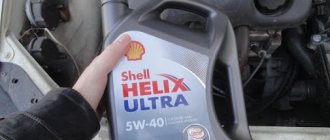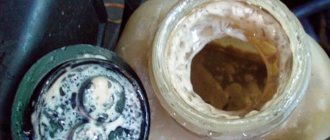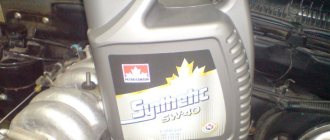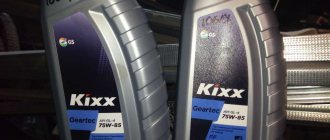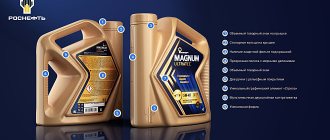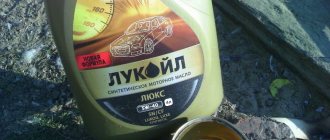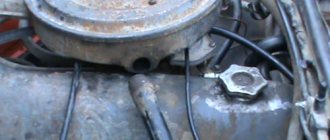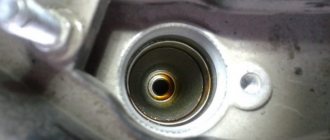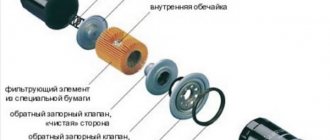The design of an internal combustion engine requires a constant supply of lubricant to various elements and components, as well as effective cooling. To solve the problem, special channels are made in the cylinder block and cylinder head through which the working fluid of the cooling system (cooling jacket) circulates, as well as the oil channels of the lubrication system.
During engine operation, a fairly common malfunction is engine oil getting into the cooling system. Oil in antifreeze can be found on any engine (gasoline, diesel, naturally aspirated, turbocharged, in-line, boxer, etc.)
It is important to understand that such a problem is serious, and the engine itself needs immediate repair. In this article we will look at the main reasons why oil appears in the engine cooling system, and also talk about the available diagnostic methods for eliminating such a breakdown of the power unit.
Signs of oil getting into antifreeze
There are a number of typical signs by which you can understand that engine oil is getting into the coolant (antifreeze or antifreeze). Regardless of exactly how much grease gets into the antifreeze, the signs listed below will indicate a problem that needs to be solved as quickly as possible in order to prevent serious and expensive repairs to the car’s engine.
So, signs of oil leaking into antifreeze include:
- Change in color and consistency of coolant. Normal working antifreeze is a clear liquid that is blue, yellow, red or green. Its darkening for natural reasons occurs for quite a long time, and is usually comparable to a routine replacement of the coolant. Accordingly, if the antifreeze has darkened ahead of schedule, and even more so, its consistency has become thicker, with admixtures of fat/oil, then this indicates that the oil has gone into the antifreeze.
- There is a greasy film on the surface of the antifreeze in the expansion tank of the engine cooling system. It is visible to the naked eye. Typically, the film has a dark tint and reflects light rays well in different colors (diffraction effect).
- The coolant will feel oily to the touch. To convince yourself of this, you can drop a small amount of antifreeze on your fingers and rub them between your fingers. Pure antifreeze will never be oily; on the contrary, it will evaporate quite quickly from the surface. Oil, if it is present in antifreeze, will be clearly felt on the skin.
- Change in antifreeze odor. Typically, coolant has no odor at all or has a sweetish aroma. If oil gets into it, the liquid will have an unpleasant burnt smell. And the more oil in it, the more unpleasant and distinct the aroma will be.
- Frequent engine overheating. Due to the fact that oil reduces the performance characteristics of antifreeze, the latter is not able to properly cool the engine. This includes reducing the boiling point of the coolant. Because of this, it is possible that antifreeze will be “squeezed out” from under the radiator cap or the cap of the expansion tank of the cooling system. This is especially true for engine operation in the hot season (summer). Often, when the engine overheats, its uneven operation is observed (it “troits”).
- Oil stains are visible on the walls of the expansion tank of the cooling system.
- There may be oil deposits on the cooling system expansion tank caps and/or the radiator cap on the inside, and an emulsion of oil and antifreeze will be visible from the top under the cap.
- When the engine speed increases, air bubbles escaping from the liquid are visible in the expansion tank. This indicates a depressurization of the system.
The above information is organized in the table below.
| Signs of breakdown | How to check for a breakdown |
| Change in coolant color and consistency | Visual inspection of coolant |
| Presence of an oil film on the coolant surface | Visual inspection of the coolant. Check for oil stains on the inner walls of the cooling system expansion tank |
| The coolant has become oily | Tactile coolant check. Check the inner surface of the expansion tank and radiator caps of the cooling system |
| Antifreeze smells like oil | Check the coolant using your sense of smell |
| Frequent engine overheating, antifreeze squeezing out from under the expansion tank cap, engine “troubles” | Check the antifreeze level in the system, its condition (see previous paragraphs), coolant pressure |
| Air bubbles escaping from the cooling system expansion tank | The higher the engine operating speed, the more air bubbles there are; in any case, this indicates depressurization of the system |
Thus, if a car owner encounters at least one of the signs listed above, then it makes sense to perform additional diagnostics, check the condition of the antifreeze, and, accordingly, begin to search for the reasons that led to the presented situation.
Fault detection
This problem, or rather, a serious breakdown, is quite insidious and does not appear immediately. Liquid lubricant passes through microcracks in small portions, without having a particular effect on the operation of the power unit. Changes become noticeable at the next stage, when the channel connecting the two systems expands and the mixing speed increases.
How to determine whether lubricant has gotten into antifreeze:
- due to the deterioration of the cooling properties of antifreeze, the engine begins to heat up more often, the electric fan operates more often;
- the oil level gradually decreases, and the antifreeze level increases (it’s quite difficult to notice);
- the pump impeller whips up the oil-water mixture, turning it into a thick white emulsion that clogs the filter, causing the engine lubricant pressure to drop;
- drips are visible on the outside of the block or heat exchanger body, originating near the gasket (they do not always appear);
- the oil in the expansion tank changes the color and consistency of the coolant.
Important! The most obvious sign of mixing, monitored visually, is a white emulsion in the expansion tank with antifreeze. If you find a similar substance in the tank, compare this fact with other symptoms - constant overheating of the engine and signals from the oil level warning lamp.
As a rule, trouble does not come alone. Antifreeze that gets into the oil pan can create serious problems: at best, the emulsion will clog the lubricating channels and filter. In the worst case scenario, the crankshaft will rotate the bearings (sliding bearings) as a result of oil starvation. Expensive repairs are guaranteed.
Often the gasket bursts all the way to the cylinder walls, after which antifreeze gets into the combustion chambers (its channels are closer). The sign of a breakdown is clearly visible - white smoke pours out of the exhaust pipe in large quantities, and the engine power drops sharply.
When a similar problem occurs on a machine equipped with a heat exchanger - a motor lubricant cooler, diagnostic difficulties arise. If there are no external signs in the form of drips, then after identifying the emulsion in the expansion tank, it is better to contact a car service center. There, both units will be purged with a special installation and the culprit will be determined by air leakage.
Reasons for oil getting into antifreeze
Why does oil go into antifreeze? In fact, there are a number of typical reasons why this malfunction occurs. And in order to understand why exactly the oil went into antifreeze, it is necessary to perform additional diagnostics of the condition of individual engine elements.
We list the typical causes from the most common to the rather rare:
- Burnout of the cylinder head gasket. It can be either natural wear or incorrect torque during installation (ideally, you should tighten it with a torque wrench), misalignment during installation, incorrectly selected size and/or gasket material, or due to overheating of the motor.
- Damage to the cylinder head plane. For example, a microcrack, sinkhole, or other damage may occur between its body and the gasket. In turn, the reason for this may be hidden in mechanical damage to the cylinder head (or the engine as a whole), or head misalignment. It is also possible that corrosion may occur on the cylinder head housing.
- Wear of the gasket or failure of the heat exchanger itself (another name is the oil cooler). Accordingly, the problem is relevant for machines equipped with this device. The gasket may become weak due to age or improper installation. As for the heat exchanger body, it can also fail (a small hole or crack appears in it) due to mechanical damage, aging, and corrosion. As a rule, a crack occurs in the pipe, and since the oil pressure at this point will be higher than the antifreeze pressure, the lubricating fluid will also enter the cooling system.
- Crack in the cylinder liner. Particularly from the outside. Thus, as a result of engine operation, oil entering the cylinder under pressure through a microcrack can flow in small doses into the coolant.
In addition to the listed typical reasons that are typical for most gasoline and diesel engines, some engines have their own design features that can cause oil to leak into antifreeze and vice versa.
One of these engines is a 1.7-liter diesel engine for Opel under the designation Y17DT manufactured by Isuzu. In particular, in these engines the injectors are located under the cylinder head cover and are installed in glasses, the outer side of which is washed with coolant. However, the sealing of the glasses is ensured by rings made of elastic material, which hardens and cracks over time. Accordingly, as a result of this, the degree of sealing decreases, which makes it possible that the oil and antifreeze will mix together.
In these same engines, cases are occasionally recorded where, as a result of corrosion damage to the cups, small holes or microcracks appear in their walls. This leads to similar consequences for mixing the mentioned process fluids.
The above reasons are systematized in the table.
| Reasons for the appearance of oil in antifreeze | Elimination methods |
| Cylinder head gasket burnout | Replacing the gasket with a new one, tightening the bolts to the required torque using a torque wrench |
| Damage to the cylinder head plane | Grinding the plane of the block head using special machines at a car service center |
| Failure of the heat exchanger (oil cooler) or its gasket | Replace the gasket with a new one. You can try to solder the heat exchanger, but this is not always possible. In the latter case, you need to replace the part with a new one. |
| Loosening the cylinder head bolts | Setting the correct tightening torque using a torque wrench |
| Crack in cylinder liner | Cleaning the surface with a grinding wheel, chamfering, sealing with epoxy pastes. At the final stage, steel surfacing was performed using cast iron rods. In the most severe case, complete replacement of the cylinder block |
Signs and causes of malfunction
- The first sign of such an unpleasant situation is a change in the color and consistency of the liquid.. It is imperative to find out why there is oil in the expansion tank. By pulling out the dipstick and looking closely, you will notice that the engine oil has become significantly lighter in color. Its natural color is black or dark brown. Mixing with antifreeze, it acquires a soapy tint and a white film appears. Depending on the type of coolant, the mixture may also acquire a yellowish tint. A characteristic odor may appear.
- The next sign is a noticeable decrease in the level of antifreeze or antifreeze, depending on the cooler you use . Look under the engine on dry asphalt. If it is dry there, then the liquid goes into the pan. In addition, traces of oil will appear on the cap or neck of the tank. Thick white smoke from the exhaust pipe will also help prevent the problem. If you see one, take action immediately.
Consequences of oil getting into antifreeze
Many, especially novice, car enthusiasts are interested in the question of whether it is possible to drive when oil has got into the antifreeze. In this case, it all depends on exactly how much oil got into the coolant. Ideally, even if there is the slightest leak of lubricant into the antifreeze, you need to go to a car service center or garage, where you can carry out repair work yourself or seek help from specialists. However, if the amount of oil in the coolant is small, then you can still drive the car a short distance.
It is necessary to understand that oil not only reduces the performance of antifreeze (which leads to a decrease in engine cooling efficiency), but also causes harm to the overall cooling system. Also, often when such emergency situations occur, not only the oil gets into the coolant, but also vice versa - antifreeze gets into the oil. And this can already lead to significant problems during the operation of the engine itself. Therefore, when the mentioned problem is identified, repair work must be carried out as quickly as possible, since delaying it is fraught with the occurrence of more serious breakdowns and, accordingly, expensive repairs. This is especially true for operating the machine in hot weather (summer), when the operation of the engine cooling system is critical for the power unit!
As a result of using coolant that contains motor oil, the following problems with the car engine may occur:
- Frequent overheating of the engine, especially when operating the machine in hot weather and/or operating the engine at high speeds (high loads).
- Clogging of cooling system elements (hoses, pipes, radiator elements) with oil, which reduces their efficiency down to a critical level.
- Damage to cooling system elements made of non-oil resistant rubber and plastic.
- Reduced service life not only of the engine cooling system itself, but also of the entire engine as a whole, since with a faulty cooling system it practically begins to wear out or in a mode close to it.
- If not only the oil gets into the antifreeze, but also vice versa (antifreeze flows into the oil), this leads to a decrease in the efficiency of lubrication of internal engine parts, protecting them from wear and overheating. Naturally, this also negatively affects the operation of the motor and its normal service life. In critical cases, the engine may partially or even completely fail.
Thus, it is better to start repair work as early as possible in order to minimize the negative impact of the lubricating fluid not only on the cooling system, but also to prevent a negative impact on the car engine as a whole.
Is it possible to drive with oily antifreeze?
If signs of oil getting into the cooling system are detected, the car can be driven only to get home or the nearest service station. It is necessary to eliminate the identified malfunction as quickly as possible. Operating a car in which lubricant and antifreeze are mixed for a long time will lead to serious damage, so you need to act quickly to get out of the situation with minimal consequences and minimal expenditure of money.
To avoid such problems, if it is necessary to add antifreeze, you should use only the same liquid as has already been filled. It is necessary to monitor the technical condition of the car. If you find signs indicating that oil is entering the cooling system, you need to find the cause and eliminate it immediately. If you can’t do this yourself, you need to turn to specialists.
What to do if oil gets into antifreeze
The performance of certain repairs depends on the reason why oil appeared in the antifreeze tank and in the cooling system as a whole.
- Damage to the cylinder head gasket is the most common and easily solvable problem if there is engine oil in antifreeze. There is only one solution - replacing the gasket with a new one. You can perform this procedure yourself, or by turning to the experts at a car service center for help. It is important to choose a gasket of the correct shape and with the appropriate geometric dimensions. And you need to tighten the mounting bolts, firstly, in a certain sequence (the diagram is indicated in the technical documentation for the car), and secondly, using a torque wrench in order to strictly maintain the recommended tightening torques.
- If the cylinder head (its lower plane) is damaged, then two options are possible. The first (more labor-intensive) is to sharpen it on an appropriate machine. In some cases, the crack can be repaired with high-temperature epoxy resins, chamfered, and the surface cleaned with a grinding wheel (on a machine). The second way is to completely replace the cylinder head with a new one.
- If there is a microcrack on the cylinder liner, then this is a rather complicated case. So, to eliminate this malfunction, you need to seek help from a car service center, where there are appropriate machines with which you can try to restore the functionality of the cylinder block. In particular, the block is bored out and new liners are installed. However, often the entire block is replaced.
- If there are problems with the heat exchanger or its gasket, then it is necessary to dismantle it. If the problem is with the gasket, it needs to be replaced. The oil cooler itself has become depressurized - you can try to solder it or replace it with a new one. Before installation, the repaired heat exchanger must be rinsed with distilled water or special products. However, in most cases, repairing the heat exchanger is impossible due to the very small size of the crack and the complexity of the device design. Therefore, it is replaced with a new one. The heat exchanger can be checked using an air compressor. To do this, one of the holes (inlet or outlet) is plugged, and the air line from the compressor is connected to the second. After this, the heat exchanger is placed in a tank with warm (important!!!, heated to somewhere around +90 degrees Celsius) water. Under such conditions, the aluminum from which the heat exchanger is made expands, and air bubbles will emerge from the crack (if there is one).
When the cause of the breakdown has been identified and eliminated, do not forget that you must replace the antifreeze and also flush the cooling system. It must be carried out according to a standard algorithm and using special or improvised means. If there is a mutual exchange of liquids and antifreeze also gets into the engine oil, then you need to change the oil with preliminary cleaning of the engine oil system.
How to flush the cooling system from emulsion
Flushing the cooling system after engine oil has entered it is a mandatory step, and if you neglect flushing the emulsion and only add fresh antifreeze, this will greatly affect its service life and operation.
Before flushing, old spoiled antifreeze must be drained from the system. Instead, you can use special factory products for flushing cooling systems or so-called folk ones. In the latter case, it is best to use citric acid or whey. An aqueous solution based on these products is poured into the cooling system and driven for several tens of kilometers. Recipes for their use are given in the material “How to flush the cooling system.” After flushing, new antifreeze must be added to the cooling system.
Conclusion
You can use a car that has oil in its cooling system only in the most extreme cases, for example, to get to a car service center. Repair work must be carried out as early as possible, identifying the cause and eliminating it. Using a car in which engine oil and coolant mix together in the long term is fraught with very complex and expensive repairs. So if you notice oil in antifreeze, sound the alarm and prepare for the costs.
How to solve a problem?
So, if the reason for mixing consumables is mechanical damage to the oil cooler gasket, then it is necessary to replace it.
What will you need?
For this you will need:
- about 12-15 liters of distilled water;
- new oil cooler gasket;
- new antifreeze;
- container for collecting old refrigerant.
Distilled water - up to 15 liters may be required to completely flush the system, please keep this in mind
New heat exchanger gasket. The shape of the gasket will be different for each individual car model.
New antifreeze. Purchase only original fluid in accordance with the requirements of the automobile class=”aligncenter” width=”800″ height=”480″[/img] Old container for draining used refrigerant. You can use a bucket or a regular cut bottle
Step-by-step instruction
So, let's start replacing:
- If possible, add a special cleaning fluid to the refrigerant. Start the engine and let it run for a while (no more than 10 minutes). To allow the engine to warm up to operating temperature, wait for the cooling fan to start. It is recommended to flush the system before replacing the oil cooler gaskets.
- After washing, find the antifreeze drain plug under the bottom of the car. Place an old basin or any other container under it, unscrew the lid and drain the used refrigerant.
- After this, you need to dismantle the oil cooler. For each individual vehicle, instructions for disassembling the oil cooler may differ, so we recommend that you use the service book for your car. After disassembling the unit, you need to clean it completely. Remove old gaskets that have expired and install new ones in their place. Buy gaskets according to your car model. If you don't know which one is best to buy, consult your dealer.
- Having replaced the gasket, you can begin to remove the refrigerant expansion tank. Rinse it as much as possible. It won't be possible to wash it completely, so if you are too concerned about its appearance, you can replace the tank with a new one.
- When the coolant is drained and the expansion tank is flushed, you need to flush the system several more times. Replace the tank and fill it with distilled water. Start the engine and turn off the air flow inside the car. Also turn on all voltage consumers to maximum so that the motor warms up faster. When the operating temperature of the internal combustion engine rises to 100 degrees, the cooling system fan will turn on. Let the engine run for about 10 minutes, while turning off all voltage consumers and turning on the interior airflow. The motor will begin to cool slightly and the cooling fan will turn off. Wait about 15 minutes for the motor to cool slightly, otherwise you may get burned when draining the distillate. Drain the distilled water and repeat the procedure at least one more time. The system must be flushed until the drained distillate becomes almost transparent. Of course, it should be free of any traces of motor fluid.
- After this, you can tighten the drain plug and fill in fresh antifreeze. Use only original products recommended by the car manufacturer. If you purchase a counterfeit, this may be fraught with other problems.
- Start the engine and press the gas pedal firmly several times. At this point you will need the help of another person. When you press on the gas, an assistant should squeeze the cooling system pipes. In this case, the expansion tank cap must be closed. This is done in order to prevent the occurrence of air jams and eliminate those that have already appeared in the system. Open the expansion tank cap from time to time to release any trapped air.
First of all, it is necessary to completely drain the coolant from the system. The photo shows a clear example where oil gets into the refrigerant, causing the consumable to become dirty in color.
After this, you need to dismantle the oil cooler (heat exchanger). It is located next to the cylinder block and looks something like this (depending on the car model, the design may differ).
Remove the heat exchanger in accordance with the car manufacturer's recommendations specified in the vehicle's operating manual. You also need to completely disassemble it.
With the heat exchanger assembly removed, your engine will look something like this. After dismantling, the oil cooler must be cleaned. As for the gasket, you need to buy an original spare part.
Completely clean the oil cooler; if necessary, use a compressor. The photo shows a cleaned unit with a new gasket.
Also remove the coolant expansion tank and clean it completely. It is important that there are no traces of lubricant left in the reservoir.
Now you need to flush the cooling system. To do this, pour distilled water into the expansion tank and start the engine, letting it run for at least 10 minutes.
Repeat the procedure for flushing the system until the flowing water is pale in color (depending on the color of the refrigerant filled previously) or completely transparent.
What to do?
There is no need to pre-sentence the block or head. Perhaps this is not the problem at all. If the engine design requires an oil heat exchanger, you should proceed as follows. You need to find the coolant inlet and outlet pipes and loop them using a tube.
Then you need to drive such a car for about 50 kilometers. If oil no longer enters the expansion tank, then the problem has been detected. In such a situation, it is enough to change the heat exchanger in which the breakdown occurred. We also suggest watching a useful video on this topic.
Broken engine head
This cause of car malfunction will be an order of magnitude more serious than a breakdown of the oil cooler. The head and block are very important places in the engine compartment, because this is where the cylinders, combustion chambers, etc. are located. From the inside the head is washed with oil, and from the outside along the contours it is cooled with antifreeze. In this case, the oil pressure is higher than the pressure in the cooling system, and therefore lubricant can get into the antifreeze through cracks.
The metal casing, through which the circuits of the systems are separated from one another, has holes. They are equipped with gaskets that normally prevent the mixing of antifreeze and oil, and it is they that can cause such a leak. There are several reasons for this. The first possible option is the gasket itself being corroded when mixing coolants. Due to ignorance or inexperience, car enthusiasts can sometimes add antifreeze of another brand or manufacturer to the cooling system, instead of completely replacing it.
Such savings, in the end, are very expensive, since fluids may contain different additives, and when they react with each other, they form a mixture that is harmful to the engine. It is the chemical solution that eats up the head gaskets, forming cracks, and sometimes leads to the formation of cracks in the metal parts of the circuits themselves. The second reason for gasket leakage is more commonplace. They may simply wear out.
During vehicle operation, the engine housings and heads experience certain mechanical influences from other elements of the power unit, as well as temperature loads. The result of this is the appearance of cracks in the gaskets. If the cause of the mixing of oil and antifreeze was identified precisely in a leaky gasket, a complete replacement of the consumable will help eliminate such a malfunction.
It is much worse when everything is in order with the gaskets and the cooling system, and the reason for the penetration of liquids into other circuits is cracks in the engine block head itself. This can be determined by removing the head and checking its tightness by crimping. Detected cracks can be eliminated by subsequent grinding or welding. To brew them in the head efficiently, you need an experienced master.
Damage to the motor gasket is the main reason for lubricant getting into the antifreeze.
Not all service station workers can cope with such a task, and therefore a complete replacement of the engine block head is often required. This type of repair is the most costly both in time and financially.
Please note: the appearance of cracks in the cylinder head can be caused by a piston hitting it
There are also frequent cases when careless motorists, during the operation of their “iron horse,” simply do not take into account elementary physical phenomena and themselves provoke the appearance of cracks in the head. An example is liquid frozen to the state of ice in winter. In addition, sudden temperature changes in summer, which occur when the cooling compound overheats while driving a car, are harmful.
The liquid poured into the system, expanding under the influence of high temperature, begins to flow out and evaporate. At this time, the driver himself, in order to eliminate this phenomenon, begins to add new fluid, but this time cold. The result of such improper handling of a car engine is microcracks, which can be pressed into the engine unnoticed by the eye. This is exactly how antifreeze turns out to be in oil or lubricant in liquid.
What actions should I take?
First of all, find out why antifreeze began to leak into the car oil (how to find out the reason was written above). In most cases, you need to change the lining by checking the engine parts. If the block head is in good condition and has no noticeable cracks or holes, then repairs will not be expensive. If there is severe deformation, the worn part will need to be replaced. Remember that there is no point in repairing a broken block head. It's easier to replace it with another one.
Once you have eliminated the root cause, flush the cooling and lubrication system completely. You will need to disassemble the pipes and clean the oil channels. It's quite difficult. The mixture of coolant and lubricant is not easy to remove from parts. Use cleaning products that clean the engine from various contaminants.
Curdled oil in antifreeze negatively affects engine performance. Bearings become coked, lubricant is deposited on spare parts, and the corrosive effect increases. If you ignore the problem, the power unit will jam and major repairs will be required.
When purchasing a vehicle, be prepared for the fact that you will need to carry out maintenance yourself. All recommendations are written in the operating manual. Once you understand how a car works, you are unlikely to pour antifreeze into the lubricant complex.
Such knowledge comes with experience. The more experienced the driver, the more procedures he can perform independently. This makes it possible to save your own money, since you do not need to pay car service employees for work.
To ensure that your vehicle serves you for as long as possible, follow the recommendations prescribed by the car manufacturer in the owner's manual. Fill the engine with only those consumables that are optimal for your power unit. If you find it difficult to choose the optimal cooler/oil, contact an experienced driver or a service center employee. Proper car maintenance is a guarantee of long-term operation of the car.
If there is a crack in the cylinder block
This is the most serious outcome of events. In this case, the entire block needs to be replaced. The procedure is quite complicated and expensive. The price is comparable to the cost of a whole engine from disassembly. Whether to install another motor or change the unit on the old one is up to each owner to decide individually. However, this operation is very difficult to perform on your own. The work requires not only experience and knowledge, but also the availability of special tools.
Main reasons
There are several main reasons for the release of coolant through the expansion tank.
They are divided into several groups depending on what exactly the problems are associated with.
Similar phenomena occur on a variety of vehicles, including:
- VAZ 2114;
- Gazelle;
- KAMAZ;
- DAF;
- Lada Kalina;
- Nissan Almera;
- Mitsubishi Lancer;
- Hyundai Accent;
- Volkswagen Polo;
- Nissan Qashqai;
- Daewoo Lanos;
- Lada Granta;
- Mazda 6;
- Mercedes;
- Audi A5, etc.
The likelihood of encountering a similar problem is higher for cars with a higher mileage. Although we cannot rule out antifreeze emissions from cars that were only recently purchased and put into operation.
Let's look at the possible reasons separately.
Tank malfunctions
At first it may seem that the tank is designed extremely simply, and there simply cannot be any significant problems with it.
But it is because of the tank that the coolant most often begins to eject.
The seal is broken. Antifreeze has a high fluidity, which is why it can penetrate even through small cracks that are not visually noticeable. Thus, when the pressure increases, the liquid is squeezed out. Check for stains under the car after parking. It is best to completely replace the tank if there is leakage; Defective threaded connections
When checking the expansion tank cap, pay attention to the threads of the neck and the valve itself. Cheap and low-quality products often have burrs and chips, which make a tight fit impossible.
An increase in pressure provokes coolant leakage through these channels; Valve. The valve cover is also a common cause of fluid leaking from the reservoir. Moreover, the problem is quite easy to identify. Everything works fine at idle. But by increasing the speed, under load, the liquid is literally pushed out from under the valve. First try to disassemble and clean the element. If this does not help, the valve needs to be replaced.
But these are not the only possible reasons. Let's move on in search of the truth.
Coolant circulation is impaired
If circulation is disrupted, the fluid overheats greatly, pressure increases and coolant is squeezed out through the valve cover.
There are several reasons here.
The potential reasons don't end there
There is one more important point that is worth paying attention to
Leak formation
Most often, motorists are faced with a shortage of coolant in the cooling system. When the volume of antifreeze drops, the temperature rises as the engine cools. Heating leads to active evaporation and an increase in pressure.
If, when the engine cools down, the level remains unchanged in the tank, then you need to look for a problem in the circulation. And when the level drops, then the seal is broken. That means there is a leak somewhere.
There are several main probable causes of leakage:
- The pipes and hoses of the system are worn out and aged. They will need to be replaced, strengthening the new parts with additional clamps to increase the reliability of the connections;
- Cracks in the heater cores and cooling system. If the problem is in the stove, then antifreeze will leak into the cabin. Usually at the front passenger's feet;
- Problems with the pump and thermostat seals. Look for traces of antifreeze near those elements that act as suspects;
- The cylinder head gasket is broken. In this case, the cylinder head gasket will need to be replaced. The danger is that the coolant can penetrate the engine cylinders or lubrication system, mixing with the oil. The consequences can be extremely disastrous for the engine, including jamming of the internal combustion engine.
Now you are clearly convinced that there is nothing good in throwing out antifreeze through the expansion tank. When the first signs appear, be sure to stop the car, start looking for the causes and eliminating them.
If you have any difficulties with diagnostics or repairs, you can always contact a car service center.
Thanks everyone! Subscribe, invite your friends to join us and expect a lot of new and useful materials!
(14 ratings, average: 4.79 out of 5)
Problems with diesel engines
Diesel engines are more susceptible to depressurization. Especially when the car has been idle for a long time. When the engine is constantly cold, the cylinder heads are susceptible to thermal deformation. As a result, the gaskets are displaced, which leads to the merging of liquids.
By the way, diesel cars more often need to change oil and filters.
The key to long-term car service is keeping the engine clean, as well as timely replacement of the car oil along with the coolant.
This must be done according to the schedule provided for a specific machine model. It is also important to do preventative maintenance from time to time.
